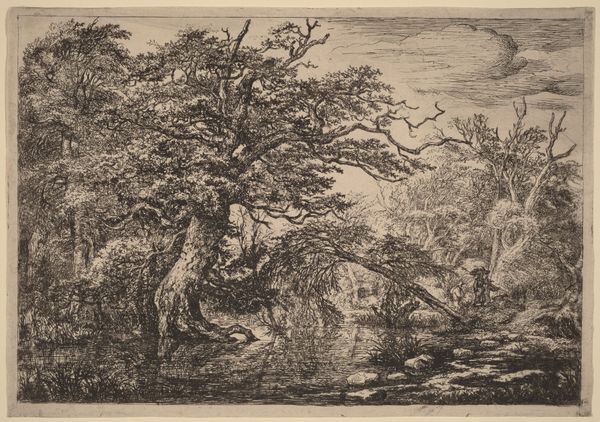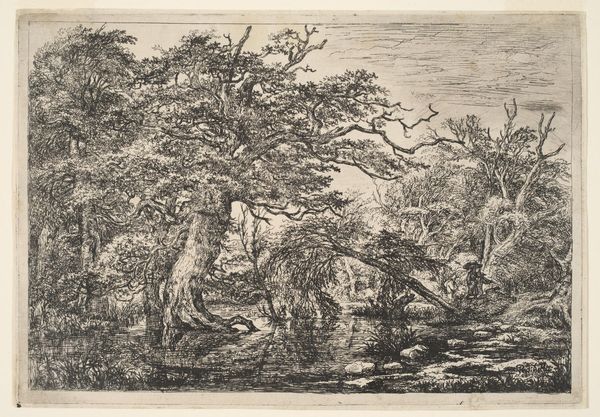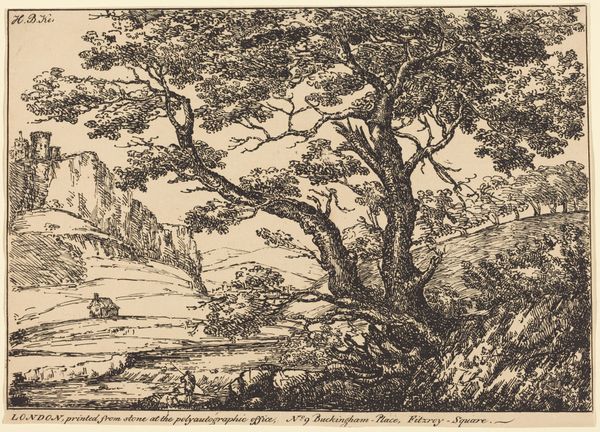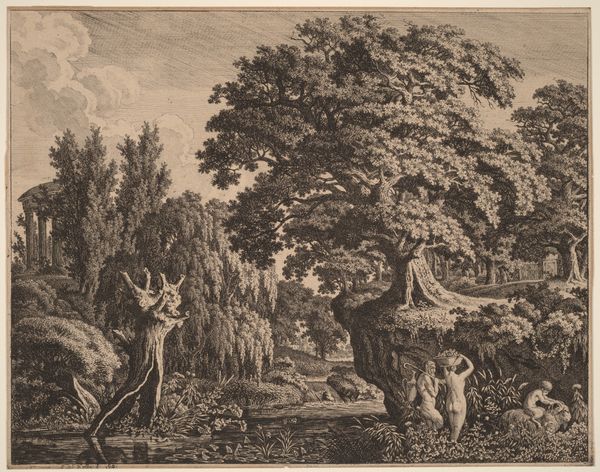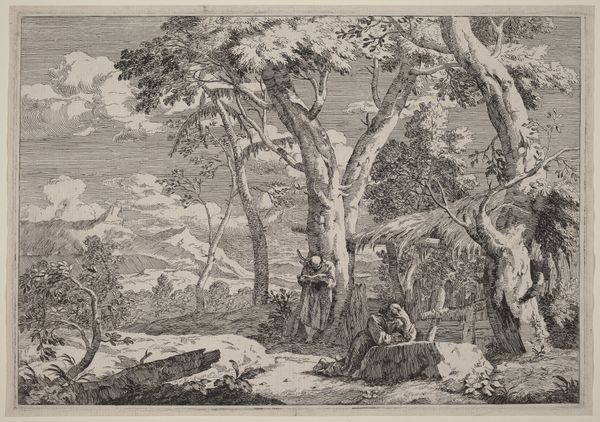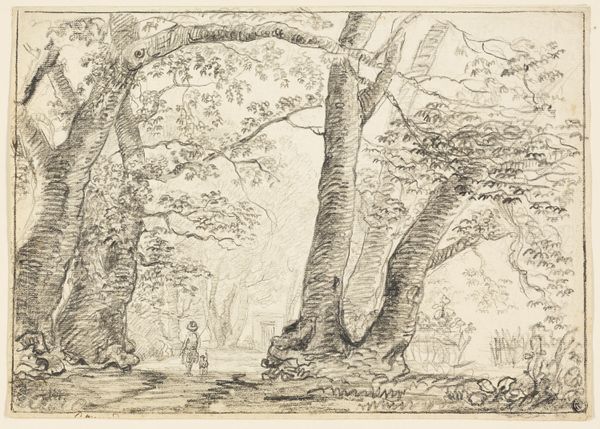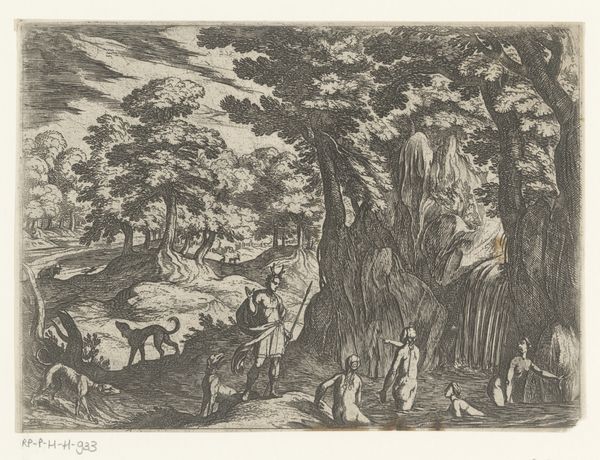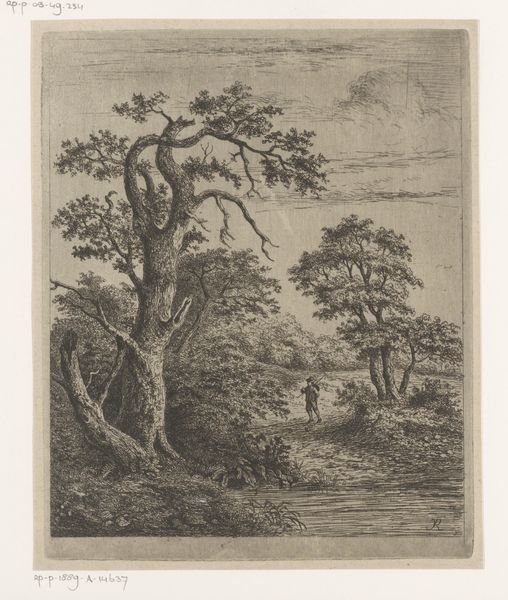
A Forest Marsh with Travelers on a Bank 1651 - 1655
0:00
0:00
drawing, print, etching, drypoint
#
drawing
#
baroque
#
dutch-golden-age
# print
#
etching
#
landscape
#
drypoint
Dimensions: 7 1/8 × 10 9/16 in. (18.1 × 26.83 cm) (plate, sheet, trimmed at edges)7 3/8 × 10 3/4 in. (18.73 × 27.31 cm) (mount, strips along edges of sheet)
Copyright: Public Domain
Curator: Here we have "A Forest Marsh with Travelers on a Bank," an etching and drypoint print by Jacob van Ruisdael, likely created between 1651 and 1655. It's currently held in the collection of the Minneapolis Institute of Art. Editor: It feels a bit ominous, doesn’t it? A still, almost oppressive landscape. All that dense foliage, reflected perfectly in the water... it's beautiful but makes me uneasy. Curator: Ruisdael certainly had a way of capturing the sublime, didn't he? Look at the meticulous detail achieved with etching and drypoint. Each tiny stroke brings the forest to life – the gnarled branches, the textures of the bark... it’s almost photographic. Editor: Except that it isn't, is it? I'm curious about the process itself. Etching requires acid, skill, and time. Drypoint involves scratching directly into the plate. It is labor intensive and I imagine highly specialized and reliant on access to tools and workshop spaces. These processes democratized image making somewhat compared to painting, but by how much? Were the prints destined for wealthy merchant homes? Were the workers part of a larger atelier? I think looking into who produced the plates is integral. Curator: That’s an interesting perspective, moving beyond aesthetics to consider the means of production. But speaking of aesthetics, those tiny figures... almost swallowed by the grandeur of the natural world. It really reinforces a sense of human insignificance, don't you think? We're merely passing through. Editor: Insignificant, perhaps, or working class, making their way through difficult terrain to survive. I also notice the relatively plain paper. Did Ruisdael personally have access to the tools for printing, or would a whole host of workers be required? Curator: Perhaps both are true. Ultimately, I am still struck by how Ruisdael transforms simple lines into a potent emotional landscape. A reminder of nature's enduring power... and our fleeting existence within it. Editor: And I am left wondering how access to tools, labor hierarchies, and modes of circulation shaped and conditioned both this image and its perception for a wealthy or aspiring bourgeois audience. Fascinating.
Comments
minneapolisinstituteofart almost 2 years ago
⋮
Jacob van Ruisdael is among the most highly regarded landscape artists of Holland’s Golden Age. He was a prolific painter and made about a dozen etchings. In The Travelers, he wielded the etching needle with exceptional freedom and expressive force, a departure from the delicacy normally seen in the work of his forebears and contemporaries. As is evident in this brilliant impression, the light is diffuse but infinitely varied despite the simplicity of his two-bite etching technique. Ruisdael’s treatment of the foliage animates the gnarled trees of the swampy lowland scene. Though the title seems to emphasize the human presence, it is really just a means to distinguish this plate from other landscapes, and one has to search a moment just to find the woman, two men, and dog, who skirt the water’s edge.
Join the conversation
Join millions of artists and users on Artera today and experience the ultimate creative platform.
